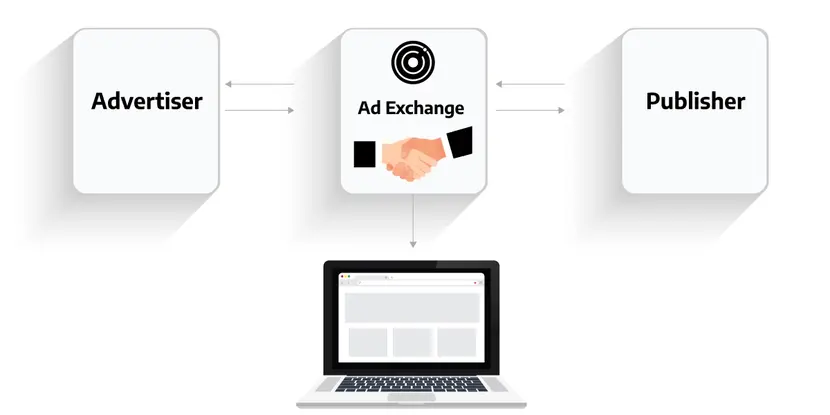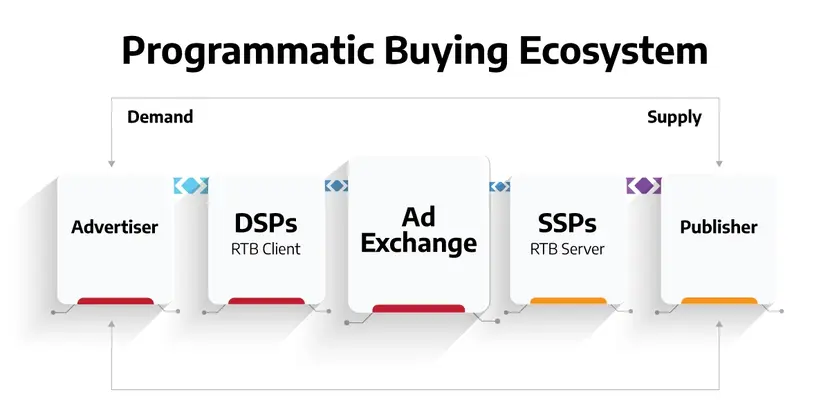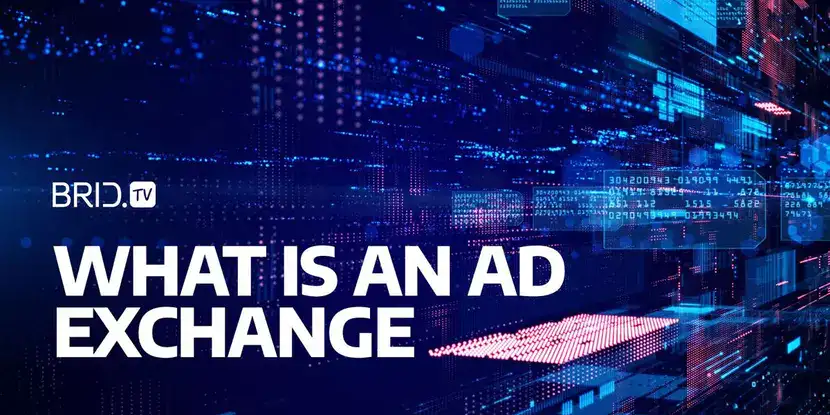It is expected that the digital advertising spending worldwide would grow to $389 billion in 2021. This means that online advertising will account for almost half of the global ad market. Almost every brand you know has an active presence on the internet and is willing to allocate their marketing budget for promotion on the web. That’s one of the most effective ways to reach target audiences nowadays.
The industry has evolved over the years because of the close relationship that publishers and advertisers share. With the developments in technology, advertisers can show relevant ads to customers at the right time, while publishers can supply the ad inventories to make it happen. Ad exchanges have a major role to play in this landscape.
However, before ad exchanges emerged, advertisers used to purchase ad space online directly from publishers and their sales teams. But this process was time-consuming and expensive for all involved. New ways to purchase advertising space on the internet began popping up, including real-time bidding (RTB), private marketplaces, and ad exchanges, making the programmatic advertising landscape easier to navigate.
Indeed, ad exchanges have made the process of buying and selling ad space more effective and more efficient. But what is an ad exchange exactly? How does it work? In this article, we’ll help you learn the ropes of this advertising technology!
What Is an Ad Exchange?

An ad exchange refers to a digital marketplace that enables publishers to sell their ad inventory and advertisers to bid on and purchase that inventory in real-time. Buyers secure this advertising space in order to deliver display, video, and mobile ads to their target audience. In today’s programmatic advertising ecosystem, all transactions are handled exclusively through real-time auctions.
Furthermore, an advertising exchange does not serve either the buyer or the seller, i.e. the advertiser or the publisher. It operates as an autonomous platform that facilitates the whole process of programmatic ad buying. Its approach is technology-driven, which differs from the historical approach of two sides negotiating price on a particular media inventory.
During real-time bidding, the highest bid wins an ad inventory. Some advertisers are willing to go over their marketing budgets if that means their ads will appear on the websites of premium publishers. They have a chance to compete for those sites thanks to advertising exchanges.
And that’s the ad exchange definition! Now, how does an ad exchange work exactly?
How Does an Ad Exchange Work?

An advertising exchange is a platform that stores thousands of ad impressions. Publishers make their impressions available on the platform, hoping someone will purchase them. Buyers have access to these impressions, choosing which ones to buy using advanced technologies such as demand-side platforms. Those decisions are often based on information like user behavior, device type, geolocation, and more.
All of this happens in a few milliseconds and the process follows these steps:
- A publisher makes their ad inventory available on an advertising exchange through a supply-side platform (SSP). They provide all necessary information such as page location, audience data, and other.
- An advertiser connects to an ad exchange through a demand-side platform (DSP), looking to bid for the available space.
- The process begins when a user visits a publisher’s website or mobile app. If there’s an ad space there, then one ad request is sent to advertising exchanges and DSPs via the publisher’s ad server.
- Then, the ad exchange sends a bid request to demand-side platforms. They inspect the request and information to determine whether that particular impression is of interest to the advertiser. If it is, DSPs send a reply to the advertising exchange with the information it needs.
- The ad exchange analyzes the user data to determine the most relevant bidder for that inventory. This technology wants to ensure that only suitable ads are considered for the space, eliminating advertisers who do not meet the requirements.
- Having gathered all data, the advertising exchange selects the highest and most suitable bidder.
- The winning ad appears on the publisher’s website.
The entire ad exchange bidding process takes place in the time it takes for a website to load. This means that the user is not even aware of what’s happening behind the scenes. As a result, programmatic advertising does not interfere with the user experience or slow down the page loading time.
Note: An ad exchange is a platform that connects DSPs and SSPs, bridging the gap between advertisers and publishers!
What Are the Benefits of Using an Ad Exchange?
Today, with the developments in ad tech, it’s much easier to buy and sell ads through advertising exchanges. These platforms have become more attractive and more efficient compared to other approaches. After we had an ad exchange explained, you’ve probably realized that real-time bidding is at the heart of this technology. This brings the following advantages to publishers and advertisers:
- Transparency — Advertising exchanges enable advertisers to see which websites are serving their ads.
- Targeting options — Advertisers also have numerous targeting options, including geolocation, language, user demographics, and more. This allows them to serve the ads to the right audience.
- Real-time insights — The data advertisers receive from advertising exchanges is extremely valuable. They can recognize which audiences they should aim to reach. As a result, they can adjust their targeting strategies.
- Efficient media buying — Due to efficient spending and a wide range of targeting possibilities, advertisers waste less money on irrelevant users through ad exchanges.
- Ad filtering and blocking — Publishers can filter or block ads with sensitive content or ads from their competitors.
- Ad types — Publishers can define which types of ads can appear on their websites by choosing ad formats.
As you can see, advertising exchanges bring a lot to the table. They are beneficial for both publishers and advertisers, which is why they are now an integral part of most online advertising efforts.
Even though we’ve done ad exchanges 101 in this article, we understand how easy it can be to confuse this technology with ad networks. That’s why we’re highlighting the main differences between the two!
Ad Exchange vs. Ad Network — What’s the Difference?
A question we get often is: “What is an ad exchange vs. an ad network?” We get why people wonder that since it may seem that the two services operate in a similar fashion. However, there are some distinctions between them.
An ad exchange is a virtual marketplace where supply and demand come together to trade inventories via real-time auctions. It gathers publishers and advertisers in order to sell inventory to the highest bidder based on available information.
An ad network acts as an aggregator that collects ad inventories from publishers and offers them to advertisers. Basically, it is an intermediary. This technology emerged once it became difficult for the two sides to negotiate deals manually.
Both ad exchanges and ad networks play an important role in the programmatic advertising ecosystem. However, they work differently. Ad exchanges are platforms advertisers and publishers use to buy and sell directly, while ad networks aggregate inventory and sell it for a profit. The latter is a closed group of privately traded ads.
Ad Exchange vs. Supply-Side Platform — What’s the Difference?
Let’s also do a supply-side platform vs. ad exchange comparison. Is there any difference between the two? Well, the technologies they use are similar, but they are not the same.
Basically, an ad exchange enables SSPs and DSPs to connect with each other. It is an autonomous platform that facilitates the entire buying and selling process. On the other hand, an SSP is what publishers leverage to plug in multiple exchanges, rather than work with just one. It’s a way to make your inventory available to as many potential buyers as possible.
Best Ad Exchanges for Publishers
How many ad exchanges are there? No one can tell you the exact number, but the ad exchange market is thriving. Although we can’t specify the amount of these platforms, we’ve prepared a list of some of the best ad exchanges that are a great place to start for publishers and advertisers.
Google Ad Exchange
What is Google Ad Exchange or Google AdX? It is one of the largest real-time marketplaces worldwide, operating under the umbrella of Google Ad Manager. Owned by its parent company, Google, it is a real-time marketplace that connects publishers and advertisers looking to sell and buy ad inventories.
Google Ad Exchange uses open auction and private auction models to make the exchange between the parties possible. The platform provides more control to publishers over their advertising space and enables them to sell inventory directly. Google Ad Exchange revenue share, however, is confidential.
Rubicon Project
Rubicon Project uses proprietary computing systems to automate the buying and selling of digital media inventory. According to the company, more than 90% of American internet users encounter its electronic ad sales system every month. On top of that, Rubicon executes billions of transactions every month.
AppNexus
AppNexus is an advanced platform that makes it possible for publishers to increase their ad yield in real time. Perhaps one of the best features of this advertising exchange is the cloud-based software platform that improves publishers’ revenues by connecting them with third-party DSPs. Publishers can also create private exchanges, inviting a defined set of advertisers to bid for ad space.
OpenX
OpenX is a powerful programmatic ad platform that is perfect for publishers who want to take complete control over their ad inventories. The company developed an integrated technology platform that combines ad server and real-time bidding with a supply-side platform. This ensures the highest real-time value for any trade.
Closing Thoughts
Ad exchanges have improved the buying and selling of digital ad inventory. They give publishers and advertisers a platform where they can meet, do business, and profit from each other. At the end of the day, it is much easier to buy and sell ad inventory through a digital marketplace than sales teams.

